John Torrington and the other Franklin expedition mummies remain haunting reminders of that lost 1845 voyage to the Arctic that saw sailors cannibalize their crewmates in their final, desperate days.

Brian SpenceleyThe preserved body of John Torrington, one of the Franklin expedition mummies left behind after the crew was lost in the Canadian Arctic in 1845.
In 1845, two ships carrying 134 men set sail from England in search of the Northwest Passage — but they never returned.
Now known as the lost Franklin expedition, this tragic journey ended in an Arctic shipwreck that left no survivors. Much of what remains are the Franklin expedition mummies, preserved for more than 140 years in the ice, belonging to crewmen like John Torrington. Ever since these bodies were first officially found in the 1980s, their frozen faces have evoked the terror of this doomed journey.
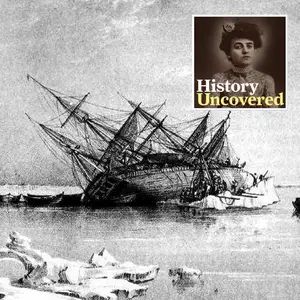
Analysis of these frozen bodies also helped researchers discover the starvation, lead poisoning, and cannibalism that led to the crew’s demise. Furthermore, while John Torrington and the other Franklin expedition mummies were long the only remains of the voyage, new discoveries have since shed more light.
The two ships of the Franklin expedition, the HMS Erebus and HMS Terror, were discovered in 2014 and 2016, respectively. In 2019, a Canadian archaeology team’s drones even explored inside the wreck of the Terror for the first time ever, giving us yet another up-close look at the eerie remnants of this grisly tale.
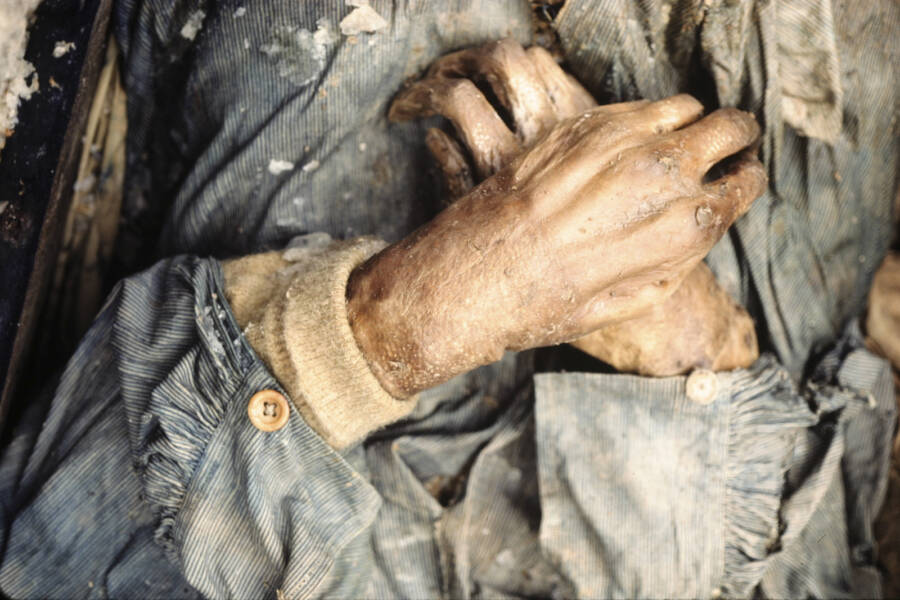
Brian SpenceleyThe hands of John Hartnell, one of the Franklin expedition bodies exhumed in 1986 and photographed by Hartnell’s own great-great nephew, Brian Spenceley.
Though the fate of John Torrington and the Franklin expedition mummies has only recently become more clear, much of their story remains mysterious. But what we do know makes for a haunting tale of terror in the Arctic.
Where Things Went Wrong With The Franklin Expedition
The unfortunate tale of John Torrington and the Franklin expedition begins with Sir John Franklin, an accomplished Arctic explorer and officer of the British Royal Navy. Having successfully completed three previous expeditions, two of which he commanded, Franklin set out once more to traverse the Arctic in 1845.
In the early morning of May 19, 1845, John Torrington and 133 other men boarded the Erebus and the Terror and departed from Greenhithe, England. Outfitted with the most state-of-the-art tools needed to complete their journey, the iron-clad ships also came stocked with three years’ worth of provisions, including more than 32,289 pounds of preserved meat, 1,008 pounds of raisins, and 580 gallons of pickles.
While we know about such preparations and we know that five men were discharged and sent home within the first three months, most of what happened next remains something of a mystery. After they were last seen by a passing ship in northeastern Canada’s Baffin Bay in July, the Terror and the Erebus seemingly vanished into the fog of history.
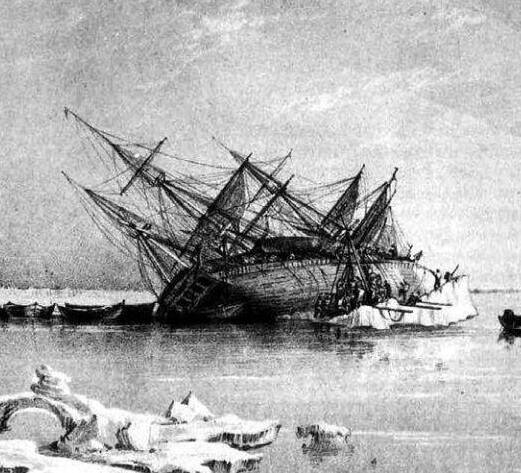
Wikimedia CommonsAn engraving of the HMS Terror, one of the two ships lost during the Franklin expedition.
Most experts agree that both ships eventually became stranded in ice in the Arctic Ocean’s Victoria Strait, located between Victoria Island and King William Island in northern Canada. Subsequent discoveries helped researchers piece together a possible map and timeline detailing just where and when things went wrong before that point.
Perhaps most importantly, in 1850, American and British searchers found three graves dating back to 1846 on an uninhabited speck of land west of Baffin Bay named Beechey Island. Though researchers wouldn’t exhume these bodies for another 140 years, they would prove to be the remains of John Torrington and the other Franklin expedition mummies.
Then, in 1854, Scottish explorer John Rae met Inuit residents of Pelly Bay who possessed items belonging to the Franklin expedition crew and informed Rae of the piles of human bones spotted around the area, many of which were cracked in half, sparking rumors that the Franklin expedition men likely resorted to cannibalism in their last days alive.
Knife marks carved into skeletal remains found on King William Island in the 1980s and 1990s back up these claims, confirming that the explorers were driven to cracking the bones of their fallen comrades, who had likely died of starvation, before cooking them down to extract any marrow in a final attempt at survival.
But the most chilling remains from the Franklin expedition came from a man whose body was actually stunningly well-preserved, with his bones — even his skin — very much intact.
The Discovery Of John Torrington And The Franklin Expedition Mummies
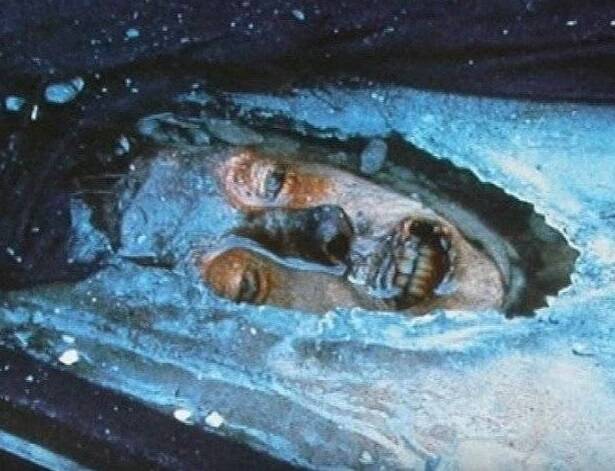
YouTubeThe frozen face of John Torrington peeks through the ice as researchers prepare to exhume the body some 140 years after he died during the Franklin expedition.
Back in the mid-19th century, John Torrington surely had no idea that his name would eventually become famous. In fact, not much was known about the man at all until anthropologist Owen Beattie exhumed his mummified body on Beechey Island nearly 140 years after his death across several excursions in the 1980s.
A hand-written plaque found nailed to the lid of John Torrington’s coffin read that the man was just 20 years old when he died on Jan. 1, 1846. Five feet of permafrost buried and essentially cemented Torrington’s tomb into the ground.
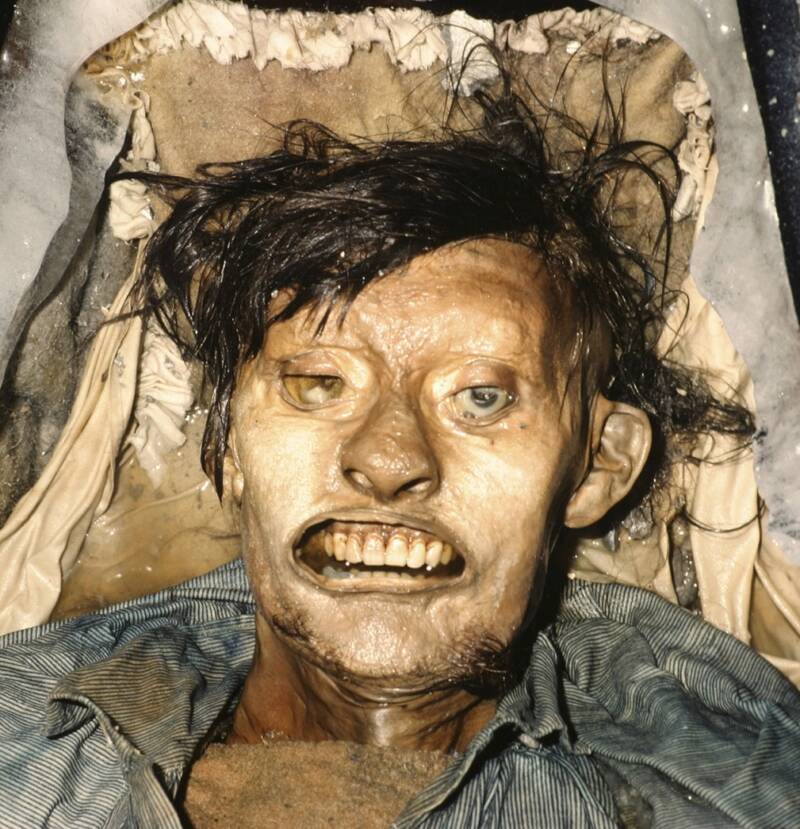
Brian SpenceleyThe face of John Hartnell, one of the three Franklin expedition mummies exhumed during the 1986 mission to the Canadian Arctic.
Fortunately for Beattie and his crew, this permafrost kept John Torrington perfectly preserved and ready to be examined for clues.
Dressed in a gray cotton shirt adorned with buttons made of shell and linen trousers, the body of John Torrington was found lying on a bed of wood chips, his limbs tied together with strips of linen and his face covered with a thin sheet of fabric. Underneath his burial shroud, the details of Torrington’s face remained intact, including a now milky-blue pair of eyes, still opened after 138 years.
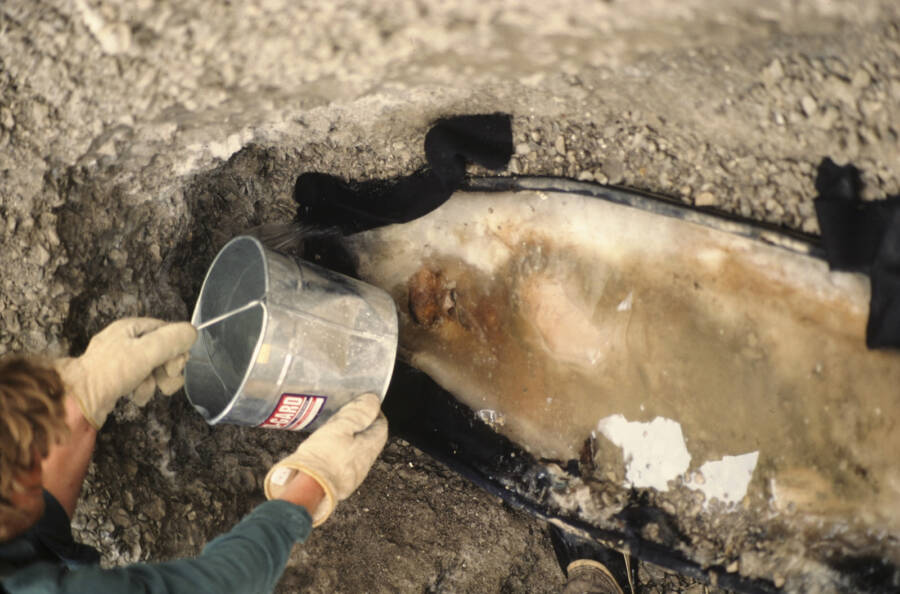
Brian SpenceleyThe crew of the 1986 exhumation mission used warm water to thaw out the frozen Franklin expedition mummies.
His official autopsy report shows that he was clean-shaven with a mane of long brown hair which had since separated from his scalp. No signs of trauma, wounds or scars appeared on his body, and a marked disintegration of the brain into a granular yellow substance suggested that his body was kept warm immediately after death, likely by the men who would outlive him just long enough to ensure a proper burial.
Standing at 5’4″, the young man weighed only 88 pounds, likely due to the extreme malnutrition he suffered in his final days alive. Tissue and bone samples also revealed fatal levels of lead, likely due to a poorly canned food supply that surely affected all 129 of the Franklin expedition men on some level.
Despite the full postmortem examination, medical experts have not identified an official cause of death, though they do speculate that pneumonia, starvation, exposure, or lead poisoning contributed to the death of Torrington as well as his crewmates.

Wikimedia CommonsThe graves of John Torrington and shipmates on Beechey Island.
After researchers exhumed and examined Torrington and the two other men buried beside him, John Hartnell and William Braine, they returned the bodies to their final resting place.
When they exhumed John Hartnell in 1986, he was so well-preserved that skin still covered his exposed hands, his natural red highlights were still visible in his near-black hair, and his intact eyes were open enough to allow the team to meet the gaze of a man who’d perished 140 years before.
One team member who met Hartnell’s gaze was photographer Brian Spenceley, a descendant of Hartnell’s who’d been recruited after a chance meeting with Beattie. Once the bodies were exhumed, Spenceley was able to look into the eyes of his great-great-uncle.
To this day, the Franklin expedition mummies remain buried on Beechey Island, where they will continue to lie frozen in time.
Recent Investigations Into The Fate Of John Torrington And The Franklin Expedition

Brian SpenceleyThe preserved face of John Torrington some 140 years after he perished.
Three decades after researchers found John Torrington, they finally found the two ships on which he and his crewmates had traveled.
When the Erebus was discovered in 36 feet of water off King William Island in 2014, it had been 169 years since it set sail. Two years later, the Terror was discovered in a bay 45 miles away in 80 feet of water, in an astounding state after nearly 200 years underwater.
“The ship is amazingly intact,” said archaeologist Ryan Harris. “You look at it and find it hard to believe this is a 170-year-old shipwreck. You just don’t see this kind of thing very often.”
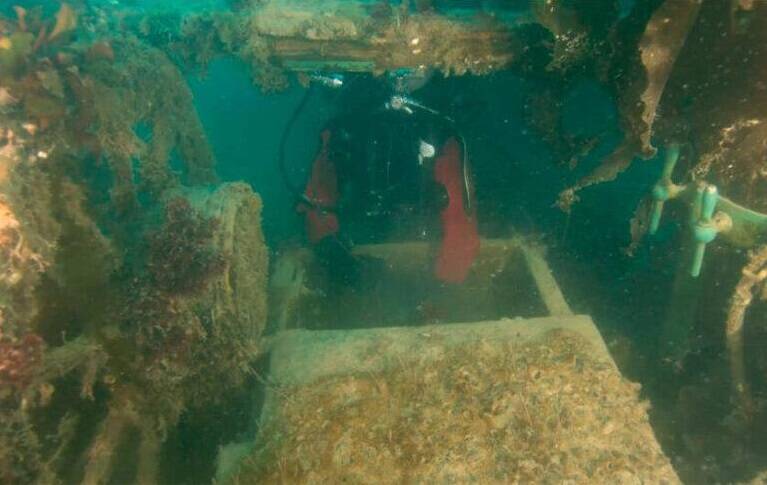
Parks CanadaThe Parks Canada team of divers went on seven dives, during which they inserted remotely-operated underwater drones into the ship through various openings like hatches and windows.
Then, in 2017, researchers reported that they had collected 39 tooth and bone samples from Franklin expedition members. From these samples, they were able to reconstruct 24 DNA profiles.
They hoped to use this DNA to identify crew members from various burial sites, look for more precise causes of death, and piece together a more complete picture of what really happened. Meanwhile, a 2018 study provided evidence that contradicted long-held ideas that lead poisoning due to poor food storage helped explain some of the deaths, though some still believe lead poisoning to be a factor.
Otherwise, big questions remain unanswered: Why were the two ships so far away from one another and how exactly did they sink? At least in the case of the Terror, there was no definitive evidence to explain how it sank.
“There’s no obvious reason for Terror to have sunk,” said Harris. “It wasn’t crushed by ice, and there’s no breach in the hull. Yet it appears to have sunk swiftly and suddenly and settled gently to the bottom. What happened?”
These questions have since left researchers looking for answers — which is precisely what archaeologists did during a 2019 drone mission that went inside the Terror for the first time ever.
The Terror was a state-of-the-art vessel and, according to Canadian Geographic, it was originally built to sail during the War of 1812, participating in several battles before its journey to the Arctic.
Reinforced with thick iron plating to break through ice and designed to absorb and equally distribute impacts across its decks, the Terror was in top shape for the Franklin expedition. Unfortunately, this wasn’t enough and the ship ultimately sank to the bottom of the ocean.
Using remote-controlled underwater drones inserted into the ship’s hatchways and crew cabin skylights, the 2019 team went on seven dives and recorded a fascinating batch of footage showcasing how remarkably intact the Terror was nearly two centuries after it sank.

Parks Canada, Underwater Archaeology TeamFound in the officers’ mess hall aboard the Terror, these glass bottles have remained in pristine condition for 174 years.
Ultimately, to answer this question and others like it, there’s much more research to be done. To be fair, the research has really only just begun. And with modern-day technology, it’s quite likely we’ll find out more in the near future.
“One way or another,” said Harris, “I feel confident we’ll get to the bottom of the story.”
But although we may uncover more secrets of the Terror and the Erebus, the stories of John Torrington and the other Franklin expedition mummies may be lost to history. We may never know what their final days on the ice were like, but we’ll always have the haunting images of their frozen faces to give us a clue.
After this look at John Torrington and the Franklin expedition mummies, learn about sunken ships way more interesting than the Titanic. Then, check out some astounding Titanic facts you’ve never heard before.





